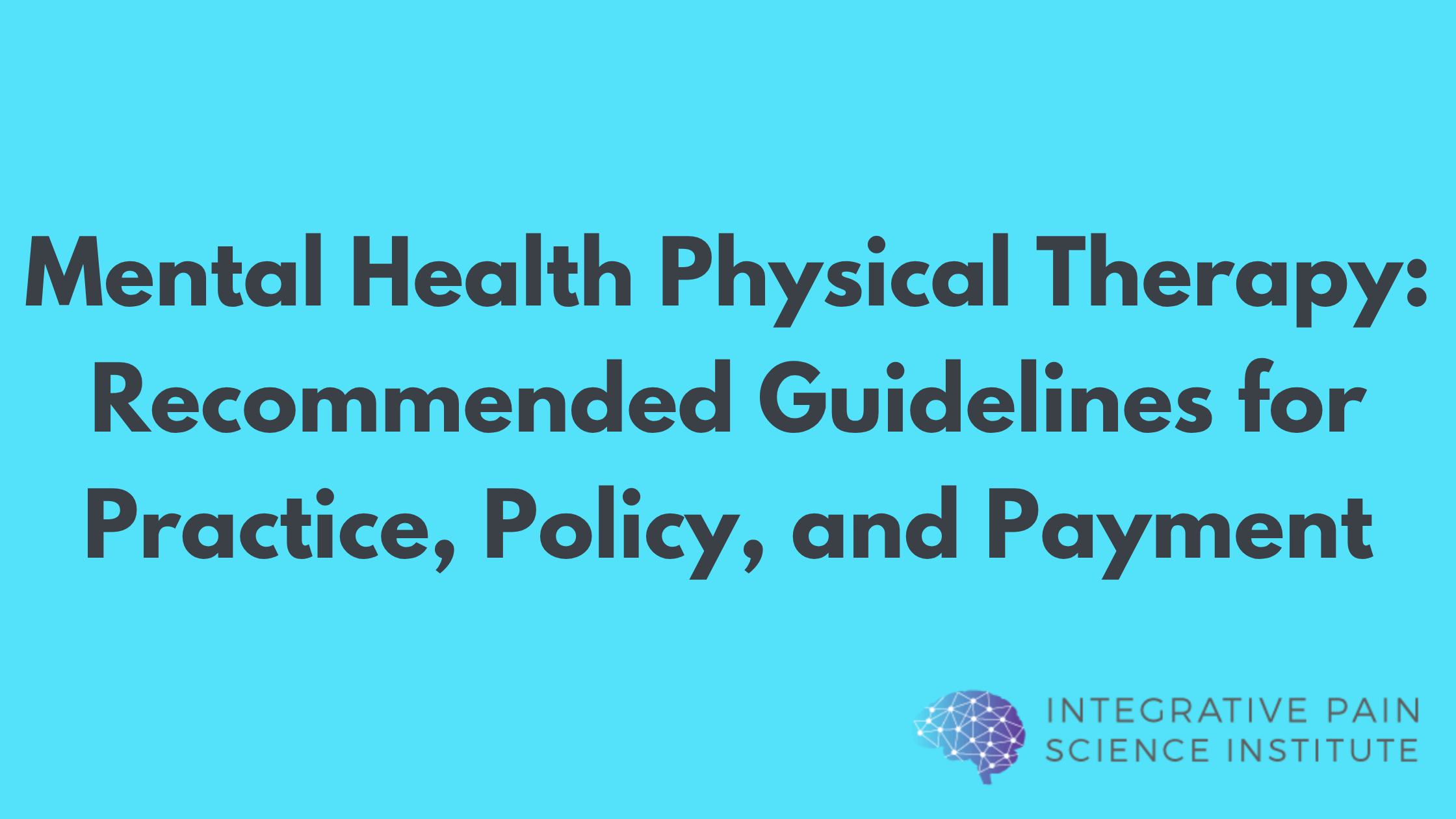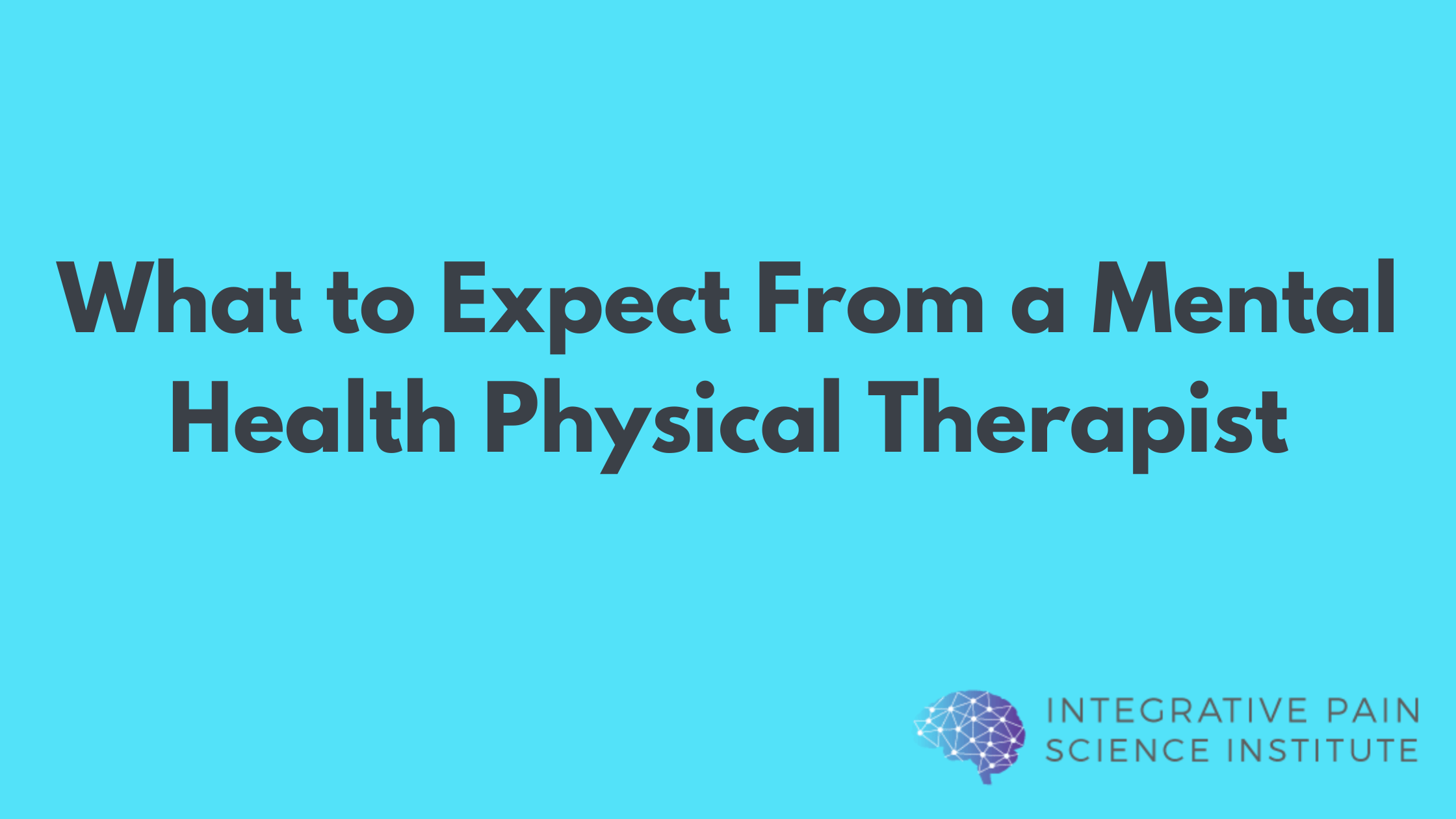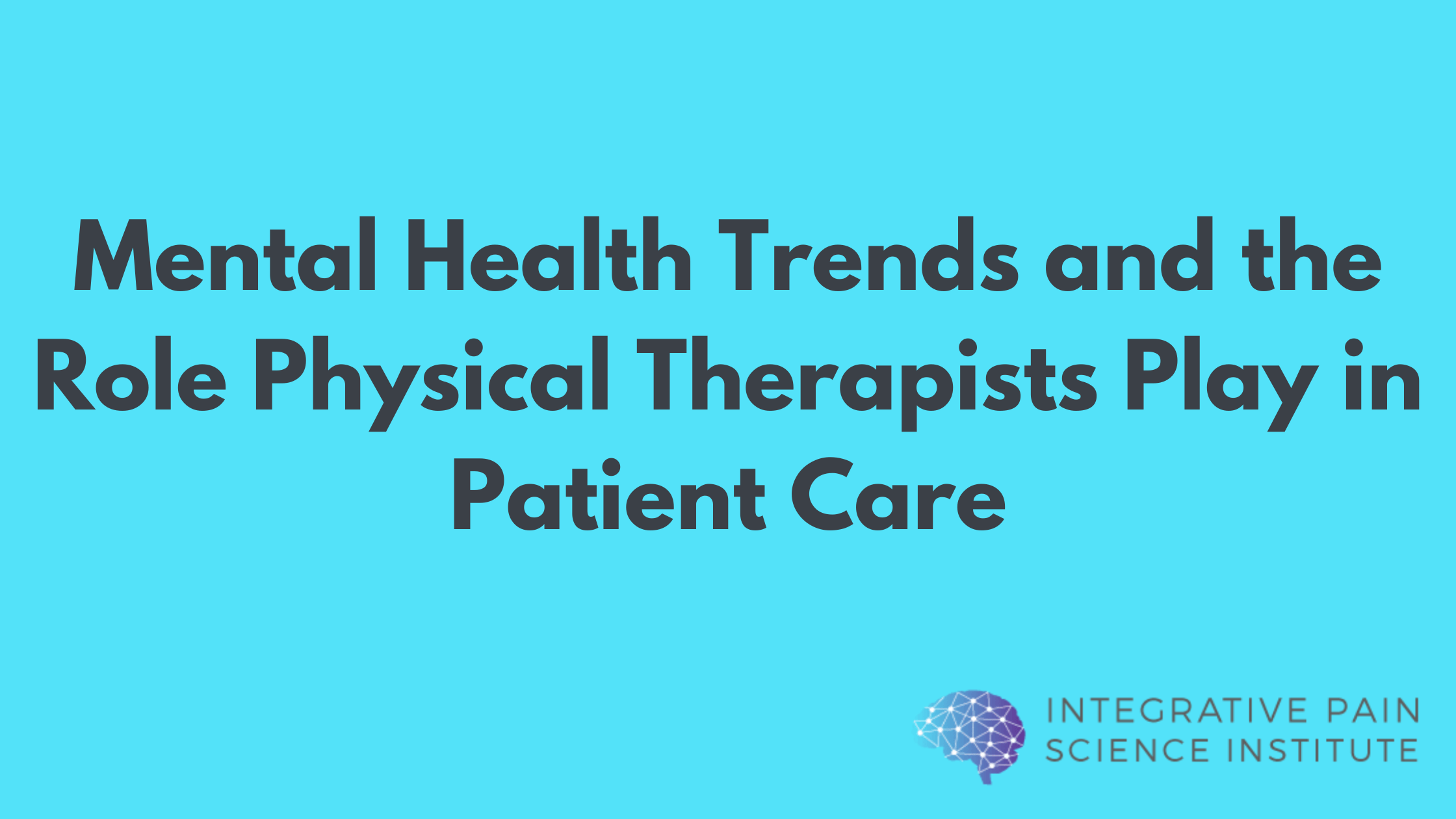7 Physical Therapy Interventions That Improve Mental Health
By Joe Tatta, PT, DPT
The relationship between physical therapy and mental health has gained significant attention in recent years. More and more research highlights how physical therapy interventions not only improve physical function but also play a crucial role in mental health. Chronic pain, physical disability, and injury can have profound psychological impacts, often leading to conditions like depression, anxiety, and traumatic stress. Physical therapists are uniquely positioned to help address both physical and mental health issues, creating a holistic approach to patient care.
In this post, we’ll explore seven common physical therapy interventions shown to improve mental health. These interventions not only help patients regain movement and physical function but also reduce symptoms of anxiety, depression, and stress, and improve overall well-being.
For a comprehensive overview of the physical therapist’s role in mental health, refer to my earlier blog post, The Physical Therapist’s Role in Behavioral and Mental Health.
Exercise Prescription for Mental Health
Exercise is one of the well-established methods for improving mental health, and PTs are experts at creating tailored exercise programs. Exercise improves anxiety, stress, and depression. decreases neuroinflammation, and improves psychological, physiological, and immunological functions.
Research shows that exercise is comparable to psychotherapy and antidepressants for treating mild to moderate depression and anxiety, making it an essential tool for PTs. In cases of severe depression, exercise should be a part of a whole-person approach to mental health and wellbeing.
How Exercise Prescription Improves Mental Health:
-
Endorphin Release: Exercise stimulates the release of endorphins, the body’s natural painkillers, which also elevate mood.
-
Reduction in Stress Hormones: Regular physical activity reduces the levels of cortisol and adrenaline, hormones associated with stress and anxiety.
-
Improved Sleep: Exercise helps regulate sleep patterns, which are often disrupted by mental health disorders.
-
Enhanced Self-Efficacy: Achieving physical fitness goals can boost self-esteem and provide a sense of accomplishment, improving overall mental well-being.
PTs can customize exercise programs based on the individual needs of the patient, taking into account their physical abilities and mental health goals. These programs may include aerobic exercises, strength training, and flexibility exercises, all of which can provide psychological benefits.
2. Mind-Body Techniques: Yoga and Tai Chi
Incorporating mind-body interventions like yoga and tai chi into physical therapy can have profound effects on mental health. These practices focus on the connection between the mind and body, promoting mindfulness, body awareness, stress reduction, and emotional regulation.
How Yoga and Tai Chi Improve Mental Health:
-
Mindfulness: Yoga and tai chi encourage patients to focus on the present moment, reducing rumination and negative thought patterns associated with anxiety and depression.
-
Stress Reduction: These practices promote relaxation and reduce the activation of the sympathetic nervous system, which is responsible for the “fight or flight” response.
-
Emotional Regulation: The slow, controlled movements and breathing exercises used in these practices help patients learn to manage their emotional responses and reduce feelings of overwhelm.
-
Increased Body Awareness: Yoga and tai chi encourage patients to pay attention to how their bodies feel, which can improve their ability to recognize and address physical and emotional tension.
Individuals who suffer from trauma-related symptoms are a unique population that could benefit from the mind-body practice delivered by a physical therapist. For PTs, integrating yoga and tai chi into a treatment plan allows patients to develop a more positive relationship with their bodies and minds, leading to enhanced mental well-being.
3. Breathing Exercises for Anxiety and Stress
Physical therapists have a 100+ year history of promotion and advancement of pulmonary physical therapy practice, education and research. Pulmonary physical therapy programs help strengthen your breathing muscles and teach you ways to manage living with chronic conditions. Breathing exercises are a simple yet effective intervention for managing anxiety and stress, and they are frequently used in physical therapy to enhance patient outcomes. Many individuals who struggle with mental health conditions exhibit shallow or irregular breathing patterns, which can exacerbate feelings of anxiety and tension. PTs can teach patients specific breathing techniques that help regulate the nervous system and improve emotional well-being.
How Breathing Exercises Improve Mental Health:
-
Activation of the Parasympathetic Nervous System: Deep, controlled breathing activates the parasympathetic nervous system, reducing the heart rate and promoting relaxation.
-
Reduction in Panic Symptoms: For individuals with anxiety, learning to control their breath can prevent hyperventilation and reduce the symptoms of panic attacks.
-
Improved Focus and Attention: Focusing on the breath can help patients shift their attention away from negative thoughts and improve concentration, which can be particularly helpful for individuals with anxiety or depression.
-
Emotional Release: Slow, deep breathing allows individuals to release pent-up emotional tension, providing a sense of emotional catharsis.
PTs can incorporate breathing exercises into almost any treatment plan, particularly for patients who experience high levels of anxiety or stress in response to pain or injury.
4. Cognitive-Behavioral Physical Therapy (CBPT)
The emerging approach of cognitive-behavioral physical therapy (CBPT) combines the principles of cognitive-behavioral therapy (CBT) with physical therapy interventions. This approach is particularly effective for patients who experience both chronic pain and mental health disorders, such as depression or anxiety.
How CBPT Improves Mental Health:
-
Identification of Negative Thought Patterns: CBPT helps patients recognize and challenge negative thoughts that may contribute to both physical and emotional pain.
-
Coping Strategies: Patients are taught specific coping mechanisms for managing pain and emotional distress, which can reduce feelings of helplessness and hopelessness.
-
Behavioral Activation: CBPT encourages patients to engage in meaningful physical activities, even when they are experiencing pain, to promote a sense of mastery and well-being.
-
Improved Pain Perception: By changing the way patients think about and respond to pain, CBPT can reduce the intensity of pain-related anxiety and depression.
PTs trained in psychologically informed physical therapy can guide patients through a process of reframing their thoughts and behaviors related to pain, leading to improved mental and emotional health. This integrated approach is particularly beneficial for individuals dealing with chronic conditions, where the physical and psychological aspects of pain are closely intertwined
5. Health Promotion Activities
Physical therapists are educated to provide services in clinical environments such as outpatient physical therapy practices or medical centers. However, they also are uniquely educated and trained to adapt health recommendations to the community where individuals live, work, learn and play (social determinants).
Physical therapists consider and account for social determinants of health in the provision of clinical and community services. This knowledge and ability enable physical therapists to adapt medical recommendations to specific environments, to provide health recommendations, and to create targeted approaches that help individuals and groups modify their health behaviors. This ensures community services are integrated and available to people beyond the clinical setting.
Health Promotion Activities Used by Physical Therapists
-
Exercise Prescription: Tailored exercise programs to promote physical fitness, flexibility, strength, and cardiovascular health.
-
Pain Science Education: Educating patients on the relationship between pain and the brain to reduce fear-avoidance behaviors and improve pain management.
-
Chronic Disease Management: Supporting patients with conditions like diabetes, obesity, or arthritis through physical activity, lifestyle counseling, and mobility training.
-
Stress Management Techniques: Introducing breathing exercises, mindfulness, and relaxation strategies to manage stress and reduce physical tension.
-
Smoking Cessation Support: Offering guidance and support to help patients quit smoking as part of overall health improvement.
-
Health Behavior Coaching: Helping patients set and achieve goals related to physical activity, nutrition, sleep, and other lifestyle factors.
-
Injury Prevention Programs: Providing pre-activity warm-ups, strength training, and sport-specific conditioning to minimize injury risks.
-
Patient Empowerment Education: Encouraging self-management skills for long-term health, resilience, and well-being.
-
Nutrition Education and Counseling: Providing nutrition education that supports pain reduction, physical recovery, and overall health.
-
Physical Activity Promotion: Encouraging regular physical activity tailored to the patient’s abilities and health status.
-
Mental Health Screening: Assessing for mental health concerns (e.g., anxiety, depression) and referring or treating as appropriate.
-
Sleep Hygiene Education: Promoting practices that improve sleep quality to enhance overall recovery and well-being. With advanced training using Cognitive Behavioral Therapy for Insomnia.
Physical therapists can address behaviors that promote health and wellness and treat and protect against chronic disease, including chronic mental health conditions.
6. Manual Therapy for Relaxation and Stress Reduction
We’ve all heard that the body keeps the score regarding our mental health. Using manual therapy techniques is a way to regulate the nervous system and improve mental wellbeing. Manual therapy, including techniques such as massage, joint mobilization, and myofascial release, is a staple of physical therapy treatment. While its primary goal is often to alleviate pain and restore function, manual therapy also has significant mental health benefits. Many manual therapies demonstrate anxiolytic effects.
How Manual Therapy Improves Mental Health:
-
Physical Touch and Comfort: Manual therapy provides physical touch, which can have a soothing effect on patients, particularly those who may be dealing with stress or emotional trauma.
-
Reduction in Muscle Tension: By reducing muscle tightness and discomfort, manual therapy can alleviate the physical symptoms of stress and anxiety, such as headaches, neck pain, and back pain.
-
Improved Circulation: Increased blood flow from manual therapy can reduce fatigue and improve energy levels, which are often low in individuals with depression.
-
Nervous System Regulation: Manual therapy can help regulate the autonomic nervous system by reducing sympathetic nervous system activity and promoting parasympathetic “rest and digest” functions, leading to feelings of calm and relaxation.
For patients who experience anxiety or stress-related muscle tension, manual therapy can be a powerful intervention that promotes both physical and emotional relief.
7. Screening, Brief Intervention & Referral to Treatment
As entry-point and primary care providers, the role of the physical therapist in mental health care should not be underestimated. Many health professionals do not have a full understanding or appreciation of the role the physical therapist plays as a gateway to good mental health care. This diagnostic and differential diagnostic process begins with a physical therapist’s ability to screen, intervene, and refer if needed. Many physical therapists are recognizing the important role they can play in substance use and/or co-occurring mental health conditions. It takes education, knowledge, and skill to screen, discuss the patient’s current condition with empathy and nonjudgement, and facilitate a referral to the appropriate provider.
Screening, Brief Intervention and Referral to Treatment (SBIRT) is an evidence-based approach recommended to identify individuals who use alcohol and other drugs (substances) at risky levels. SBIRT is valid and reliable in identifying and improving outcomes for people who use substances. The goal of SBIRT is to prevent or reduce use of substances to prevent related health consequences, disease, accidents, and injuries through an early intervention approach.
Why use SBIRT in Physical Therapy for Mental Health?
-
Identify risky or potentially risky patterns of substance use in a population
-
Provide evidence-based interventions for people who may otherwise not access care.
-
Connect people to resources, services, and supports
-
Prevent disease, accidents, and injuries.
-
Improve the health of individuals, families, and communities
-
Reduce costly healthcare utilization.
-
SBIRT is a billable service



